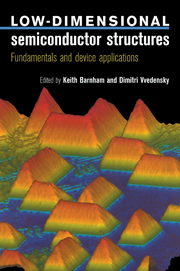Book contents
- Frontmatter
- Contents
- List of contributors
- Preface
- 1 Epitaxial Growth of Semiconductors
- 2 Electrons in Quantum Semiconductor Structures: An Introduction
- 3 Electrons in Quantum Semiconductors Structures: More Advanced Systems and Methods
- 4 Phonons in Low-dimensional Semiconductor Structures
- 5 Localization and Quantum Transport
- 6 Electronic States and Optical Properties of Quantum Wells
- 7 Non-Linear Optics in Low-dimensional Semiconductors
- 8 Semiconductor Lasers
- 9 Mesoscopic Devices
- 10 High-speed Heterostructure Devices
- Solutions to Selected Exercises
- Index
1 - Epitaxial Growth of Semiconductors
Published online by Cambridge University Press: 06 July 2010
- Frontmatter
- Contents
- List of contributors
- Preface
- 1 Epitaxial Growth of Semiconductors
- 2 Electrons in Quantum Semiconductor Structures: An Introduction
- 3 Electrons in Quantum Semiconductors Structures: More Advanced Systems and Methods
- 4 Phonons in Low-dimensional Semiconductor Structures
- 5 Localization and Quantum Transport
- 6 Electronic States and Optical Properties of Quantum Wells
- 7 Non-Linear Optics in Low-dimensional Semiconductors
- 8 Semiconductor Lasers
- 9 Mesoscopic Devices
- 10 High-speed Heterostructure Devices
- Solutions to Selected Exercises
- Index
Summary
Introduction
Epitaxial growth is a process during which a crystal is formed on an underlying crystalline surface as the result of deposition of new material onto that surface. The study of this process dates back over 150 years, but it was not until the work of Louis Royer in the 1920s that the systematics of epitaxial growth began to be revealed (Royer, 1928). Royer carried out an extensive study of the growth of ionic crystals on one another and on mica, mainly from aqueous solution and, using optical microscopy, summarized his observations with a set of rules based on crystal structure. These rules led Royer to coin the term ‘epitaxy’, which is a combination of the Greek words epi, meaning ‘upon’, and taxis, meaning ‘order’, to convey the notion of growing a new crystal whose orientation is determined by a crystalline substrate and to distinguish epitaxial growth from polycrystalline and amorphous growth. A review of the history of epitaxial growth has been given by Pashley (1956).
The modern era of the epitaxial growth of semiconductors began with the work of Henry Theurer at Bell Telephone Laboratories in Murray Hill, New Jersey (Theurer, 1961). Motivated by the need to reduce the base resistance of discrete bi-polar transistors, Theurer demonstrated that thin epitaxial silicon layers could be grown on a silicon substrate. The idea that epitaxial structures could lead to new electronic and optical phenomena was founded on a suggestion in the late 1960s by Leo Esaki and Raphael Tsu (1970), then working at the IBM Research Laboratories in Yorktown Heights, New York.
- Type
- Chapter
- Information
- Low-Dimensional Semiconductor StructuresFundamentals and Device Applications, pp. 1 - 55Publisher: Cambridge University PressPrint publication year: 2001
- 3
- Cited by



